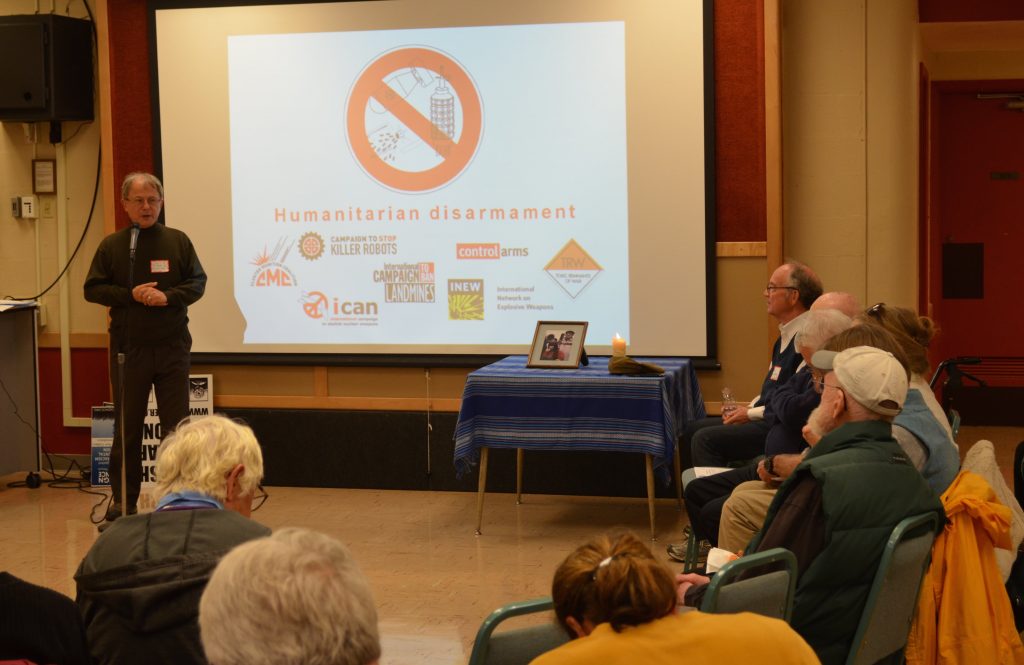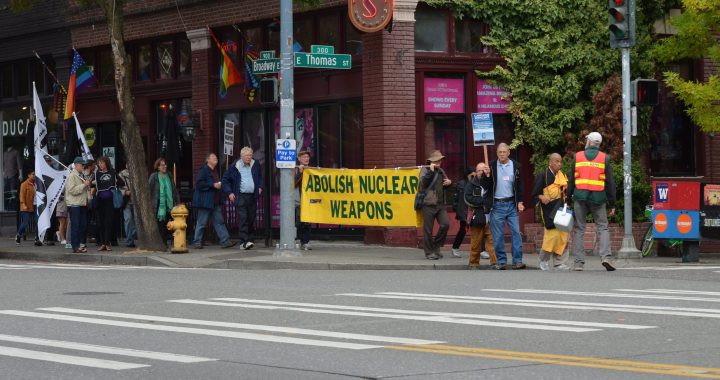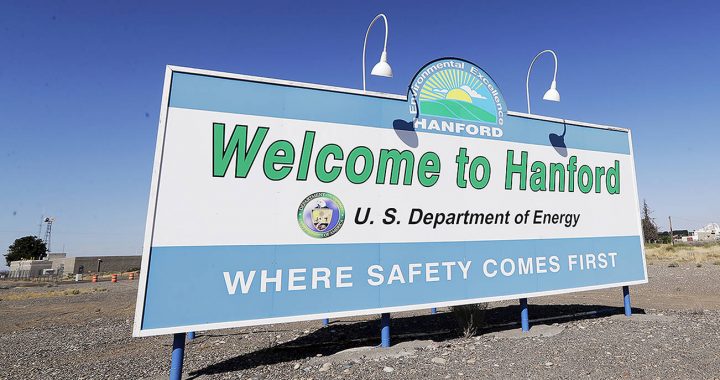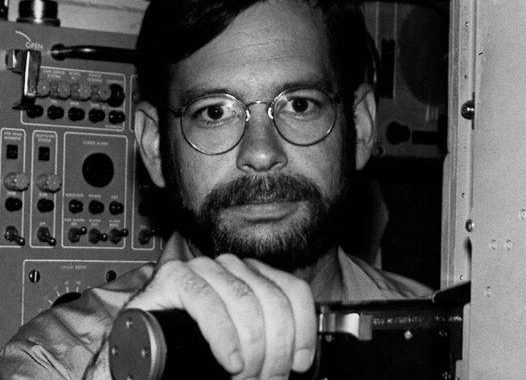On September 15, about 40 people attended the much-anticipated presentation by Yeshua Moser-Puangsuwan, a long-time human rights and humanitarian disarmament activist, author, and friend and colleague of Ground Zero members. The event was sponsored by Ground Zero Center for Nonviolent Action and Pax Christi Northwest and was one of over 2,650 events around the world as part of the 2018 Campaign Nonviolence National Week of Actions (September 15-23).
Yeshua Moser-Puangsuwan recounted the history and development of the Humanitarian Disarmament movement, beginning with his work on the International Campaign to Ban Landmines in 1994. Yeshua had just returned the previous week from an inter-governmental meeting in Geneva debating international regulations on ban fully autonomous weapons–killer robots. Other Humanitarian Disarmament campaigns include the Cluster Munition Coalition, the International Network on Explosive Weapons, and the International Campaign to Abolish Nuclear Weapons (ICAN).
The Humanitarian Disarmament movement works for the prohibition of weapons by focusing on their impact on human beings and societies, rather than the traditional state security framework. This includes nuclear weapons, as well as cluster munitions, anti-personnel mines, depleted uranium, and the use of explosive weapons in densely populated areas. Humanitarian Disarmament groups are also working to stop new weapons technology, such fully autonomous weapons currently under development, the so-called “killer robots”.
The Humanitarian Disarmament movement carries out a large proportion of its work within international coalitions, such as the International Campaign to Abolish Nuclear Weapons (ICAN) of which Ground Zero and Washington PSR are members. Efforts for disarmament may target an entire chain of conflict: from the development of new weapons, the investments by financial institutions in the production of such weapons, through the arms trade, and the use of these weapons in conflicts. Yeshua suggested that one approach in the Puget Sound region would be to urge others to withdraw monetary support from industries, banks, and other financial institutions that earn income from the nuclear weapons industry.
Core elements of Humanitarian Disarmament include three main concepts: (1) to develop a body of law; (2) a norm or guideline in which civilians and the environment on which they depend will not be harmed; and (3) a movement.
The body of law is made up of treaties and protocols brought about by civil society which have humanitarian characteristics, are people centered, with remediation elements and monitoring and advocacy by civil society.
These conventions help to create a norm that is ‘policed’ by civil society through data gathered during monitoring and “naming and shaming”.
A necessary element of Humanitarian Disarmament is to develop a movement, with large numbers of individuals and civil society organizations. In the United States, although our military is resistant to agree to humanitarian restrictions, public pressure can help enforce a new norm that makes it more difficult for the military to use certain weapons. One example is the inhibition of the U.S. to use antipersonnel landmines and cluster munitions due to pressures from outside the U.S. The norm must be constantly reinforced. Ground Zero members know that the public must be constantly reminded of the harm and risk from the development and possible use of nuclear weapons.
Yeshua’s presentation was much appreciated by those attending. Many of the concepts have been an integral part of our work. Yeshua has given us a much clearer understanding of strategy and new directions for our work for the abolition of nuclear weapons.
After the presentations, participants marched from Saint Patrick Church to Saint James Cathedral for a prayer and reflection on Archbishop Raymond Hunthausen and his contribution to nuclear disarmament.
Additional Information from Yeshua on
Humanitarian Disarmament Campaigns
International Campaign to Ban Landmines http://www.icbl.org/
Cluster Munition Coalition http://www.
International Campaign to Abolish Nuclear Weapons http://www.icanw.org/
Don’t Bank on the Bomb https://www.dontbankonthebomb.com/
Control Arms https://controlarms.org/
International Network on Explosive Weapons http://www.inew.org/
Campaign to Stop Killer Robots https://www.stopkillerrobots.
Conflict & Environment Observatory/Toxic Remnants of War https://ceobs.org/
Humanitarian Disarmament:
*A body of law, A norm, A movement
*The body of law is made up of treaties and protocols brought about by civil society which have humanitarian characteristics- people centered, with remediation elements, civil society monitoring
*These conventions create a norm, this norm is ‘policed’ by civil society through monitoring and naming and shaming
*A movement, well over 1000 civil society organizations belong to the above listed campaigns and are global in scope.
Other resources:
Humanitarian disarmament is made up of organization undertaking action from the humanitarian disarmament framework.
One entity which has written about the concept is the International Human Rights Law Clinic of Harvard Law School, especially its newly established Armed Conflict and Civilian Protection Initiative
Drones- No specific humanitarian disarmament campaign is focused on drones since it is believed to be covered by existing humanitarian and human rights law. A study on the Humanitarian Impact of Drones was released last October by Article 36, a UK based civil society group. There have also been many reports issued on the impact of drones, particularly in Pakistan and Yemen by the arms divisions of Human Rights Watch and Amnesty International.
US arms transfers to Syria question, this is a bit out of my domain, but the one I mentioned was America’s Guns: Secret Pipeline to Syria | People and Power . This particular piece of investigative journalism was done by Al Jazeera’s People & Power series. I highly recommend this series as many of them document brilliant nonviolent campaigns waged by peoples organizations in far corners of the planet. I am sure there are many other sources.
Finally, ANYONE interested in disarmament today should read the UN Secretary General’s agenda for disarmament issued in May 2018: Securing Our Common Future (also available in e-reader formats). It is a document from which you can find a lot of support, and I would draw your attention to the disarmament elements of the Sustainable Development Goals.




